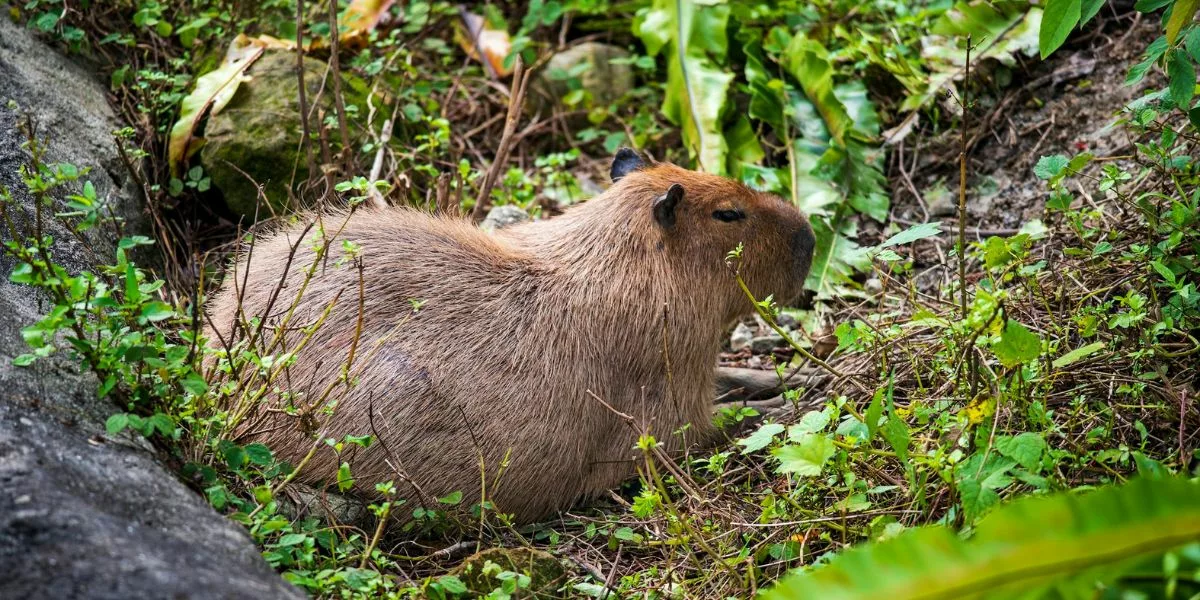Last Updated on September 30, 2024 by Our Editors
Ever wondered what it’s like to spend a laid-back day with the world’s largest rodents? Picture yourself lounging by the water, surrounded by a group of the most chill animals on the planet—capybaras! These gentle giants are natural swimmers, often found relaxing by rivers and ponds, enjoying life in their own serene way. With their easygoing nature and social personalities, capybaras have become internet darlings, charming people from all over the world.
But are capybaras friendly? In the wild, capybaras live in groups and are known for their peaceful demeanor. They rarely show aggression, even toward other species. It’s not uncommon to see them lounging with birds perched on their backs or sharing a moment with other animals at the water’s edge. Their laid-back attitude makes them seem approachable, and in some places, they’ve even become accustomed to humans, happily interacting in animal sanctuaries and nature parks.
At Ecowiser, we’re all about celebrating nature’s marvels while pushing for sustainability. Dive into this capybara adventure with us as we burst some myths and uncover the truth about these delightful creatures.
Who Are These Capybara Celebs?

Let’s kick things off by getting to know our oversized friends. Capybaras, scientifically known as Hydrochoerus hydrochaeris, are the world’s largest rodents. They’re often mistaken for pigs or beavers due to their size and appearance, but they’re unique in their own right. These semi-aquatic giants can grow up to four feet in length and weigh as much as 150 pounds—about the size of a small dog! With their webbed feet and sleek bodies, they’re perfectly designed for an aquatic lifestyle.
Capybaras are native to South America, where they live in a variety of wet habitats like rivers, lakes, and swamps. Their natural environment is a crucial part of their life, providing both food and protection from predators. But don’t be fooled by their size; these creatures are known for their gentle demeanor and sociable nature.
What Makes Capybara So Special?

So, what makes capybaras so endearing? For starters, their relaxed vibe is hard to ignore. Capybaras are often seen lounging by the water or taking leisurely swims, and their calm demeanor has made them internet sensations. From viral videos of them chilling with pelicans to their adorable hot spring soaks in Japan, capybaras have become global icons of tranquility and cuteness.
Their friendly appearance and behavior have earned them a special place in many hearts. They’re often seen interacting harmoniously with other animals and even letting smaller creatures hitch rides on their backs. This amiable attitude is one of the many reasons why people are drawn to them. But let’s not get ahead of ourselves; are these gentle giants as friendly as they seem?
Are Capybara Friendly?

Let’s set the record straight: are capybaras really as friendly as they appear? Many people assume that their serene demeanor means they’re always approachable, but it’s important to understand their behavior more deeply. Capybaras are indeed social animals, thriving in groups of 10 to 40 individuals. Their social structure is complex, and they rely on each other for protection and companionship.
Capybaras use their social skills to maintain harmony within their herds. They communicate through a range of vocalizations and body language, reinforcing bonds and coordinating group activities. Their calm appearance is often a survival strategy; by staying relaxed and non-confrontational, they minimize the risk of attracting predators.
Social Butterflies
Capybaras are known for their friendliness, but their interactions with other animals and humans can vary. In the wild, they’re often seen mingling with different species, including potential predators like caimans and jaguars. While this might seem risky, capybaras have developed a unique way of coexisting peacefully with other creatures. They’re not typically aggressive and often engage in mutualistic relationships with various animals, like birds that help them with grooming.
When it comes to interactions with humans, capybaras can be quite affectionate, especially if they’re accustomed to people. Many capybara owners report that their pets are friendly and enjoy human company. However, it’s crucial to remember that, like all wild animals, they can become stressed or defensive if they feel threatened. Respecting their space and understanding their behavior are key to maintaining a positive relationship with them.
What Do Capybaras Eat?

Capybaras are herbivores, and their diet is primarily composed of grass, aquatic plants, fruits, and vegetables. In their natural habitat, they graze on a variety of vegetation, which provides them with the nutrients they need to stay healthy. Their diet is essential not only for their well-being but also for maintaining the balance of their ecosystem.
One interesting fact about capybaras is their practice of coprophagy—eating their own feces. While this might sound unappealing to us, it’s a natural behavior that helps them digest their food more efficiently and obtain additional nutrients. This process is crucial for their digestive health, especially in the wild where food resources can be limited.
Capybaras are known for their unique eating habits. In the wild, they spend a significant portion of their day foraging and grazing. They have evolved to efficiently process large amounts of plant material, which helps them maintain their large size. In captivity, capybaras are often fed a diet that mimics their natural intake, including hay, vegetables, and specially formulated pellets.
Their feeding habits also play a role in their environment. By consuming large quantities of vegetation, capybaras help control plant growth and maintain the health of their habitat. This ecological function highlights the interconnectedness of all species and the importance of preserving natural habitats to ensure the well-being of wildlife.
How To Approach Capybaras?
If you ever find yourself face-to-face with a capybara, it’s important to approach them with care and respect. In the wild, capybaras are generally shy and will avoid human contact if possible. If you’re lucky enough to observe them, do so from a safe distance to avoid disturbing them. Here’s how:
In the Wild
If you encounter a capybara in its natural habitat, the most important thing is to approach with respect and caution. Capybaras are generally shy and elusive, preferring to keep their distance from humans. Here’s how to approach them safely:
- Observe from Afar: Keep a safe distance and use binoculars or a camera with a zoom lens to observe them without intruding. This ensures you don’t disrupt their natural behavior or stress them out.
- Move Slowly: If you need to move closer for a better view, do so very slowly. Sudden movements can startle capybaras and cause them to flee.
- Minimize Noise: Speak softly and avoid loud noises that could alarm them. Capybaras have keen hearing and can be easily disturbed by unexpected sounds.
- Avoid Direct Eye Contact: Direct eye contact can be perceived as a threat. Instead, watch them from the corner of your eye and avoid staring.
- Respect Their Space: If a capybara seems agitated or begins to move away, it’s a sign that you’re too close. Respect their space and back away to give them room to retreat.
In Captivity or Controlled Environments
When interacting with capybaras in zoos, wildlife parks, or sanctuaries, the dynamics are different. Many capybaras in these settings are more accustomed to human presence, but it’s still crucial to approach them with care.
- Approach Gently: Move towards them slowly and calmly. Sudden or rapid movements can still startle them, even if they are used to human contact.
- Respect Boundaries: Always follow the guidance provided by zookeepers or caretakers. They know the animals’ behavior and can advise on the best way to interact.
- Observe Their Body Language: Capybaras communicate through a variety of vocalizations and body language. Look for signs such as ear positions, tail movements, and vocal sounds. If they appear relaxed, you may proceed with interaction, but if they show signs of stress (like flaring ears or retreating), it’s best to step back.
- Avoid Physical Contact: Do not attempt to touch or handle capybaras without explicit permission and supervision. Even if they seem friendly, they still require a level of respect and space.
- Build Trust Gradually: If you are a caretaker or someone who interacts regularly with Capybaras, focus on building trust over time. Spend time near them without forcing interaction, and let them approach you on their own terms.
- Provide Enrichment: In controlled environments, enrichment activities can help capybaras stay mentally and physically stimulated. This can include things like puzzle feeders, toys, or different types of environmental enrichment. Engaging in these activities with the capybaras can enhance their well-being and strengthen your bond with them.
By understanding and respecting capybara behavior, you contribute to their well-being and create a positive experience for both yourself and the animals. Whether observing them in the wild or interacting in captivity, maintaining a respectful and informed approach ensures that capybaras remain comfortable and content.
Are Capybaras Endangered?

Capybaras are not currently classified as endangered, but their populations face several threats. Habitat loss due to urbanization and agriculture, as well as hunting in some areas, poses risks to their survival. While they are not on the brink of extinction, it’s important to remain vigilant and address these threats to ensure their long-term conservation.
At Ecowiser, we are committed to protecting wildlife and their habitats. Our sustainability initiatives focus on preserving natural environments and supporting conservation efforts. By raising awareness about the challenges faced by capybaras and other wildlife, we hope to inspire collective action and promote responsible practices that benefit both animals and ecosystems.
You can join our efforts by supporting organizations dedicated to wildlife conservation, spreading awareness about environmental issues, and making eco-friendly choices in your daily life. Every small action contributes to a larger impact, and together, we can make a difference.
Fun Capybara Facts

Capybaras are filled with fascinating quirks that make them even more intriguing. Here are some additional fun facts about these unique rodents:
Sociable Nature: Capybaras are incredibly social animals. They thrive in large groups and have a complex social structure. In the wild, their groups are often led by a dominant male, and they have a variety of vocalizations to communicate, including whistles, barks, and purrs. This social behavior helps them stay safe from predators and strengthens their bonds within the group.
Semi-Aquatic Lifestyle: Capybaras are semi-aquatic and spend a significant amount of time in water. They have partially webbed feet that make them excellent swimmers. Their eyes, ears, and nostrils are positioned high on their heads, allowing them to see, hear, and breathe while most of their body is submerged.
Unique Diet: Capybaras are herbivores with a diet primarily consisting of grasses and aquatic plants. They also practice a behavior known as coprophagy, where they eat their own feces to extract additional nutrients. This behavior helps them digest their food more thoroughly and is common among many herbivorous animals.
Grooming Rituals: Capybaras engage in extensive grooming rituals, often using their teeth and paws to clean each other. This grooming not only helps them maintain their hygiene but also strengthens social bonds within their group. It’s a common sight to see them gathered together, meticulously grooming one another.
Impressive Digging Skills: Although they are not primarily known for digging, capybaras can be quite adept at it. They often dig in the mud to create wallows or to search for food. These wallows help them stay cool and protect their skin from parasites.
Adaptability: Capybaras are highly adaptable and can thrive in a variety of habitats, from savannas and wetlands to forested areas. Their ability to adjust to different environments and conditions is a testament to their resilience and versatility.
Playful Behavior: Capybaras are known for their playful nature, especially among young individuals. They engage in activities such as chasing each other, splashing in water, and wrestling. This playful behavior is important for their social development and helps them build strong relationships within their groups.
These quirks and characteristics make capybaras not only endearing but also a source of endless fascination for those who study and observe them.
Learn more about Capybaras.
How To Support Capybara Conservation?

Get Involved
Supporting capybara conservation doesn’t have to be complicated. Start by spreading awareness about their importance and the challenges they face. You can also support organizations that work to protect their habitats and promote sustainable practices.
Be a Nature Advocate
Living sustainably is crucial for preserving the natural world. Simple actions like reducing waste, conserving water, and supporting eco-friendly products contribute to a healthier environment for all species, including capybaras. By making mindful choices and encouraging others to do the same, you play a vital role in protecting wildlife and their habitats.
Go Hug A Capybara Today, If You Can
Celebrate capybaras and our shared commitment to a sustainable future. These amazing creatures remind us of the beauty and diversity of the natural world and our responsibility to protect it. By keeping our waterways clean and protecting the places capybaras call home, we’re doing more than just helping these cool critters. We’re playing a part in maintaining the balance of nature that keeps everything, from the tiniest plants to the biggest animals, thriving.
At Ecowiser, we are dedicated to making a positive impact and inviting you to join us in our efforts. Together, we can ensure a thriving future for cap. Keep up the spirit of sustainability, do browse through our blog for more interesting facts.
Frequently Asked Questions (FAQs)
1. Are capybaras aggressive?
Capybaras are generally not aggressive. They are social and peaceful animals that live in groups and prefer to avoid conflict. When threatened or cornered, they may become defensive, but aggression is rare. Their docile nature makes them relatively easy to observe and interact with in controlled environments.
2. Do capybaras like being touched?
Capybaras can tolerate gentle touching, especially if they are accustomed to human interaction, as in captivity. However, wild capybaras should not be touched and should be observed from a safe distance. Always respect their personal space and follow guidance from experts when interacting with them.
3. Why is Capybara so friendly?
Capybaras are friendly due to their social nature and cooperative behavior. They live in large groups and communicate through various vocalizations and body language, fostering strong social bonds. Their calm demeanor and tolerance for other species, including humans, contribute to their friendly reputation.
4. Are capybaras good pets?
Capybaras are not ideal pets for most people due to their size, social needs, and specialized care requirements. They need ample space, a water source, and social interaction with other capybaras. They are best suited to environments where their complex needs can be met, such as wildlife sanctuaries or zoos.
5. Are capybaras rodents?
Yes, capybaras are rodents. They belong to the family Caviidae, which also includes guinea pigs and other similar animals. As the largest rodent species, they share typical rodent characteristics such as continuously growing incisors and a herbivorous diet.








